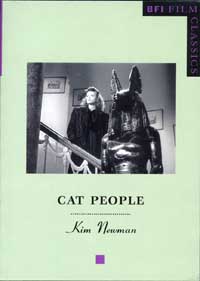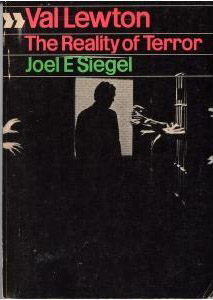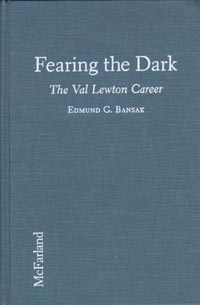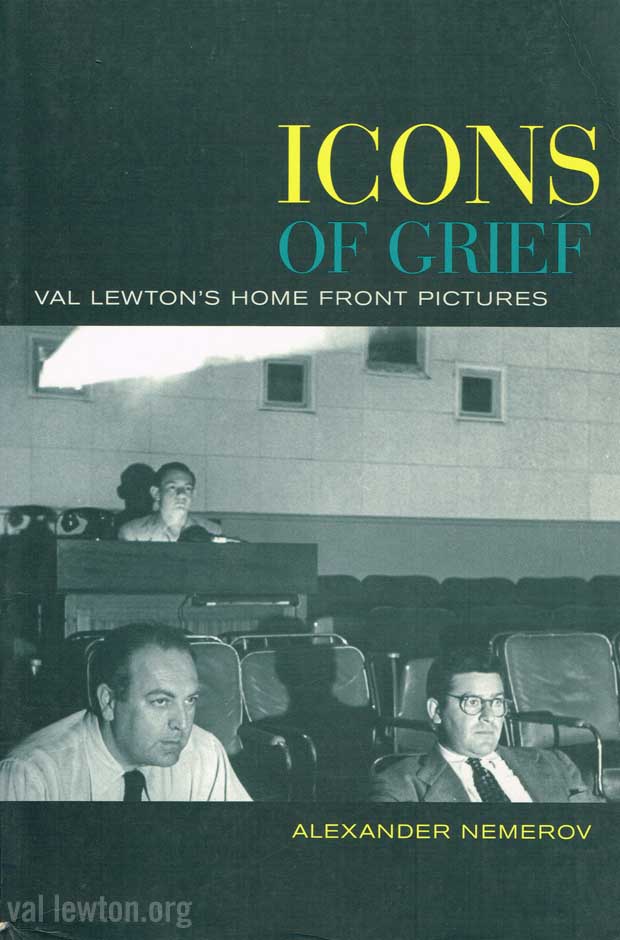Val Lewton.org
Books About Val Lewton
Kim Newman's book on Lewton's Cat People

(Above) Kim Newman's thoughtful, well-researched book on Lewton's Cat People. Part of the BFI classics film series.
AMAZON: Cat People (BFI Film Classics) By Kim Newman
Cat People
BFI Classics Film Series
By Kim Newman
80 pages, published 1999 by the British Film Institute
This small volume, part of the BFI's ongoing series discussing the films that are part of their 360 film collection, is well-written and researched. The author does not shy from questioning some of the presumed tenets of Lewton scholarship, particularly in regard to how Lewton regarded his role at the RKO unit he was in charge of. Newman's humor at contesting these ideas comes through, such as when just discussing the title, Cat People:
"The oddest thing about Bodeen, Tourneur and all Lewton commentators insist on is a contempt for the title. Bodeen has Lewton in despair giving him a chance to walk away from such an absurdly-titled project, while Tourneur – whose credits at the time included Nick Carter, Master Detective (1939), Phantom Raiders (1940) and Doctors Don't Tell (1941) and would later direct without complaint films entitled Anne of the Indies (1951) and Way of the Gaucho (1952) – simply sneers at such a 'stupid title'. What, pray, was a cat/werewolf horror movie supposed to be titled? Remembrance of Things Past? Cat People seems a simple, evocative, eerie title rather than a 1942 precursor to Frankenstein Meets the Space Monster (1965), Blood Orgy of the She Devils(1973) or Stuff Stephanie in the Incinerator (1989). It marks out territory perfectly, affords both a literal and a metaphoric reading (it's not called The Cat Woman) and has a resonance that remains sixty years on. Other studios were asking other producers to make films called King of the Zombies (1941), The Corpse Vanishes (1942), The Mad Doctor of Market Street (1942) and The Mad Ghoul(1943), suggesting what a true catchpenny, lurid, unambitious thirst for thrills might have sounded like. Of all Lewton's assigned titles, only I Walked With a Zombie and The Curse of the Cat People compete in this arena, and he only really resisted the latter. (Page 13)
Elsewhere, Newman argues that Lewton well knew he was placed in his position specifically to exploit the 'horror' genre, and did not present as much opposition to the guidelines he was given as is often supposed. On the other hand he recognizes that Lewton's personal goals tended to supersede the expectations he had been given by RKO. Also, unusual in most of the Lewton literature I have seen, Newman argues that Lewton's RKO films were not intended to be true "B" films, but more sub-budget "A," and both Lewton and the RKO executives intended that from the beginning.
(From the back-cover) "Released in 1943, Cat People was the first production from the unit set up by RKO to make low-cost, high-return horror movies. Producer Val Lewton was handed the title and ordered to come up with a film to fit. He and director Jacques Tourneur created an innovative picture about a Serbian émigré in New York (Simone Simon) who is convinced she's suffering from a hereditary curse that will transform her into a panther if her passions are aroused.
Kim Newman's books include the novels Anno Dracula, The Quorum and Life's Lottery, and the non-fiction studies Nightmare Movies and Millennium Movies. He edited the BFI Companion to Horror and is contributing editor of Sight and Sound and Empire Magazines."
I purchased the book new for $9.95 in 2001. - Erik Weems

(Above) The cover to Siegel's concise, well-written history of Lewton and his films.
AMAZON: Val Lewton: the reality of terror (Cinema one, 22) By Joel E. Siegel
Val Lewton: The Reality of Terror
By Joel E. Siegel
175 pages, The Viking Press, 1973
This was the first of the books written on Lewton, and is still the best. It makes up for whatever lack in detail about the films with brevity of analysis. Siegel seems to know exactly what he likes about Lewton's films and he gets to the point quickly. His book also has the benefit of cooperation from Lewton's family and friends, it is organized well with many long quotes from these people, which allows for much insight Lewton's personal life. Because it is the first book-length study of Lewton with access to primary sources and to Lewton's family and associates, all the material written by others since then owe a debt of gratitute to Siegel's work.

(Above: The cover to Banzak's exhaustive book on Lewton)
AMAZON: Fearing the Dark: The Val Lewton Career By Edmund G.. Banzak
Fearing the Dark - The Val Lewton Career
By Edmund G.. Banzak
571 pages, Published by McFarland & Company, 1995
Banzak's book is very enthusiastic about Lewton. This volume is the opposite of Siegel's short tome, in that Banzak seems to try to exhaust every possible element of history in connection to Lewton. Short sections are essentially history essays on the subject at hand (e.g., horror films, or a particular director) and provide enough background information for the reader to get a sense of context to Lewton and his films. If there is a particular drawback to this method, it is that the book seems geared toward the film-buff novice, while simultaneously the author writes to the reader who is familiar with the subject.
In either case, the book quotes from Siegel's book at crucial points in Lewton's life, which is probably unavoidable since so many of the sources Siegel used for the 1973 book have died. On the other hand, Banzak has interviewed Lewton's son, Val E. Jr., at length, and the quotes are very interesting and show that Banzak is hardly hero-worshipping his subject, and has taken the extra effort to gather Lewton information from areas that Siegel did not utilize (or know about). Essential reading for Lewton fans.
Dreams of Darkness
Fantasy and the Films of Val Lewton
By J. P. Telotte
224 pages, University of Illinois, 1985
AMAZON: Dreams of Darkness: Fantasy and the Films of Val Lewton
Telotte's analysis of Lewton is from the point of view of psychological description and motivation, and uses numerous literary and psychoanalytical references to describe his investigation. He provides a good history of the Lewton unit at RKO, and covers Lewton's basic biography. He asks many, many questions, not all of which he answers, which seems quite alright within the scope of what this book is exploring.
He does say that the underlying theme of Lewton's RKO films all deal with the human effort to explain the mysterious or frightening in life, and that through the use of ancient archetypes and the absence of definition in (he quotes Lewton's own words) "dark patches" the tales are human journeys trying to master the unexplainable. The book is heavily written though, in long sections that would probably be easier if the reader is familiar with Freud, Carl Jung, and others whom Telotte quotes (many of whom I have not heard of before). Not a generic film-fan book in any sense, but a real effort at finding deep meaning in Lewton's work.
More From Hollywood
By DeWitt Bodeen
345 pages, A. S. Barnes & Company, 1977
AMAZON: More from Hollywood: The Careers of 15 Great American Stars By DeWitt Bodeen
Bodeen worked for Lewton at RKO, and the 22 page portrait of Lewton in this selection of biographies (Lewton is sandwiched between Clint Eastwood and Jeanette McDonald) is a very personal remembrance.
"He loathed physical contact on a social basis; he withdrew when people patted or embraced him, and even a handshake could put him off. He said to me once: "One of the things I like about you is that you're not demonstrative. I notice that you don't even shake hands unless the other party offers their hand." I smiled, and confessed: "I don't like to shake hands, because I am convinced it's the simplest way of one person's transferring germs to another." He nodded his head approvingly. "I must remember that," he said, "it makes a good excuse." (page 309)

Icons of Grief: Val Lewton’s Home Front Pictures
by Alexander NemerovPaperback: 226 pages Publisher: University of California Press 2005
AMAZON: Icons of Grief: Val Lewton’s Home Front Pictures

"Alexander Nemerov focuses on the iconic, isolated figures who appear in four of Lewton's small-budget classics―The Curse of the Cat People, The Ghost Ship, I Walked with a Zombie, and Bedlam."